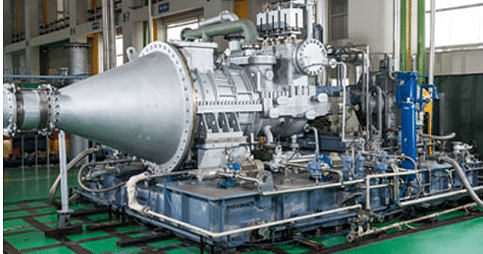Industrial heat and power solutions provider Triveni Turbines Ltd. plans to increase its manufacturing capacity to 350 turbines annually, from 225 turbines at present, as it sees demand for three product lines growing in the coming quarters.
The manufacturer of steam turbines expects its below 30 MW range to grow at a rate of 20%; while the above 30 MW-100 MW range is expected to see growth of 40–45%. The API segment that caters to the oil and gas sector is expected to grow above 70–80%.
“The last two segments are seeing high growth because of our low market share and market penetration strategy. Ultimately these capacities have to be fulfilled,” Nikhil Sawhney, vice chairman and managing director of Triveni Turbines, told BQ Prime.
“Triveni Turbines has gone from manufacturing 150 turbines to 225 turbines. Now, we will have a capacity to manufacture 350 turbines and that will be up and running by Q1 FY24.”
On a year-on-year basis, the company has seen strong growth in overall order booking and inquiries.
“Despite the fluctuations in the quarterly number, our overall inquiries have grown by 35%. The international inquiry book has grown by 55%, even as the domestic inquiry book fell by 5%,” Sawhney said.
The sectors that are growing in the economy include industries that require heat and power solutions and which are dependent on end-commodity prices, Sawhney said.
“We saw very strong growth coming from cement waste heat recovery, on the back of high raw material energy prices, such as pet coke, coal or carbon matters. That means energy efficiency has a very strong return on investment,” he said.
The company sees a clear mandate towards green energy transition, and hence, it considers investments in this field as critical.
The renewable energy power and solutions provider also expects strong demand from the distillery segment, backed by the government’s Ethanol-20 (E20) programme.
According to Sawhney, other drivers will be chemicals, carbon black, municipal solid waste incineration, biomass-based independent power producers, demand from API pharma, food processing, and rubber process co-generation.
The decline came from the metals and steel segment, on a quarterly basis, he said.
“Demand is very lumpy in nature. It comes when prices are high. There is a degree of consolidation, in terms of pricing, but the trajectory is high. Demand from the country’s perspective is going to be robust,” Sawhney said.
The company will need around Rs 35 crore in investments for capacity expansion.
The investments will mostly be in engineering and technology development. “Our investment is not very high because we manufacture IP critical equipment and then, the majority of our asset base is used towards installation testing and quality assurance of the products,” he said.
The company is extending the assembly quality and testing capacity more than its manufacturing capacity. Although, the company has ample capacity to manufacture IP sensitive equipment, it also has a set of vendors and sub-contactors who assist in overall product development, he said.
“Ultimately, the aim is to have a balance sheet where we have high asset turnover and very high return on equity and invested capital.”
Since the company does not have major experience in the inorganic acquisition space, it plans to look for markets for localised presence.
“We know where we will need the presence, what capabilities will be required and will look at bridging that. But, ultimately, it will have to fit with the mandate of what investors appreciate; that is high return on equity investment, high return on invested capital and the asset turnover should be commensurate with our past performance,” Sawhney said.
In 2022, the company acquired TSE Engineering in South Africa. “The company has performed extremely well since acquisition,” he said.
“It is a market that we studied very deeply before going. More than that, we were able to get some very good orders in South African Development Community region very quickly.”
Triveni Turbines invested around Rs 6.8 crore and were able to get around Rs 100 crore in the last two quarters. “So, with the margin profile the company has, the payback is very good,” he said.
Similar to the Production-Linked Incentives in India, there are major schemes announced in the European Union region and the U.S. as well. In the U.S., under the Inflation Reduction Act, the government has announced $269 billion in incentives for localised manufacturing.
“However, that doesn’t mean we will participate in manufacturing there. We may or may not,” he said.
At present, the company’s strategy is to cater to international markets from India. “We have ample capacity to cater to the market. The product is very technical in nature and it’s not line manufacturing that can be set up anywhere,” Sawhney said.
According to him, the indian cost structure is the best. “Even our best competitor Siemens caters to its markets from India. So, that tells how competitive our supply chain is in the sector,” he said.
“So we may not set up manufacturing capacities there, but may look at setting up assembly capacity and would definitely like to augment our services capability.”
















